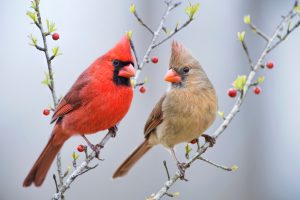6 Tips for Winter Bird Feeding
Although I’ve always been an animal lover, the older I get, the more I appreciate birds. I remember watching my grandfather feed and care for the wild birds on his property as a child and not quite understand his fascination with them. It was not until many years after he passed until I started sharing this interest. I think of him often when I look out back and admire the birds depleting my feeders. I can see him now watching them eat from his. There goes another bag of seed. Perhaps the cost is one reason that this seems to be an adult-mostly hobby.
As enjoyable as it is to stand at my back door and watch the American Goldfinches, Evening Grosbeak, Blue Jays and Hairy Woodpeckers (I want to list them all – Cardinals, Pileated Woodpeckers – but I won’t) delight in the seeds and my homemade suet each morning, I also consider how bird feeding can be life sustaining for my little friends, especially on harsh days.
I admit that this can be a controversial subject. And while I want to share that some people consider bird feeding to make birds dependent on a source of food that could immediately disappear, evidence suggests that even birds who frequent feeders visit multiple sources of food daily. Thus, they are not dependent on bird feeders.
Winters can be tough on birds and birds require more calories to keep them warm. Even drinking and staying hydrated in the winter consumes more calories as birds have to use warmth from their bodies to melt snow to consume.

While winters are particularly tough on birds, it is important to consider other factors that put stress on their populations. Some of these are human imposed such as collisions with windows. Birds can be confused by reflections of skies and trees in windows and collide. Each year an estimated one million birds die in collisions with Toronto buildings alone.
Not only is winter bird feeding an enjoyable hobby to participate in, it is also important for increasing the chances of bird survival in harsh conditions. And so, I invite you to join the exclusive world of the Honorary Wildlife Rehabber/Bird Feeder to help support your local bird populations.
Here are 6 Tips to get you started:
- Get a bird feeding pole into the ground early in the winter season. If you don’t have ground to put one in, consider hanging feeders on a deck or on the side of a house.
- Got squirrels? Listen- of course I feed my squirrels, too. But not my good bird seed. Add some hot pepper to your seed mix or suet to keep squirrels away. Birds don’t have the same taste receptors and will continue to enjoy the seeds while squirrels will be deterred by spice.
- Learn and have fun. Download the Merlin app on your phone and start differentiating between the birds. Learn what type of birds you like and what kind you want to attract. Want Cardinals? Cardinals love Sunflower and Safflower seeds and need bushes to hide in from predators (their beautiful red colours aren’t very camouflaging). I wasn’t able to attract Cardinals until I moved my feeders to a spot more desirable to them. Unfortunately, bushes can also act as hiding spots to predators such as cats. Keep feeders away from areas where predators can ambush birds.
- Share your love of birds. When I started talking to others about my birds, others became interested, too, and started participating as well. Funny enough, this helped some of my relationships to develop and bird feeding became a shared interest with others in my life.
- Get a shallow, heated bird bath to provide birds with drinking water. It will also attract different species of birds to your yard.
- Getting predators? Take down your feeders for a few days or a week and those pesky yet incredible to see Merlin’s and Owls will lose interest.
Above all, bird feeding should be enjoyable. Putting food out here and there is perfectly acceptable and, eventually, someone will find it.
Happy Birding!